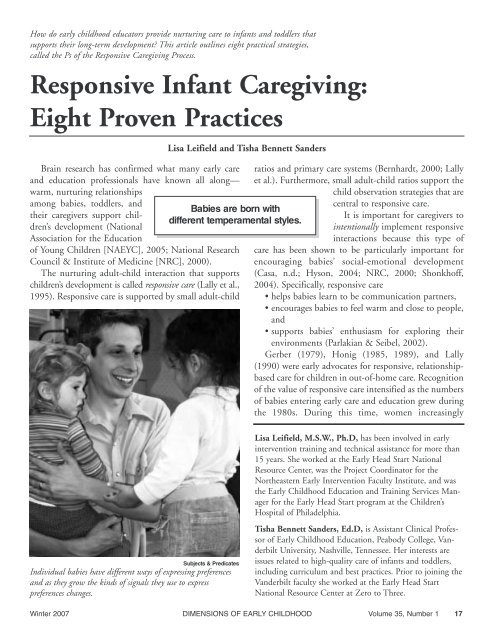Dimensions of Early Childhood - Southern Early Childhood ...
Dimensions of Early Childhood - Southern Early Childhood ...
Dimensions of Early Childhood - Southern Early Childhood ...
Create successful ePaper yourself
Turn your PDF publications into a flip-book with our unique Google optimized e-Paper software.
How do early childhood educators provide nurturing care to infants and toddlers that<br />
supports their long-term development? This article outlines eight practical strategies,<br />
called the Ps <strong>of</strong> the Responsive Caregiving Process.<br />
Responsive Infant Caregiving:<br />
Eight Proven Practices<br />
Brain research has confirmed what many early care<br />
and education pr<strong>of</strong>essionals have known all along—<br />
warm, nurturing relationships<br />
among babies, toddlers, and<br />
their caregivers support children’s<br />
development (National<br />
Association for the Education<br />
<strong>of</strong> Young Children [NAEYC], 2005; National Research<br />
Council & Institute <strong>of</strong> Medicine [NRC], 2000).<br />
The nurturing adult-child interaction that supports<br />
children’s development is called responsive care (Lally et al.,<br />
1995). Responsive care is supported by small adult-child<br />
Lisa Leifield and Tisha Bennett Sanders<br />
Babies are born with<br />
different temperamental styles.<br />
ratios and primary care systems (Bernhardt, 2000; Lally<br />
et al.). Furthermore, small adult-child ratios support the<br />
child observation strategies that are<br />
central to responsive care.<br />
It is important for caregivers to<br />
intentionally implement responsive<br />
interactions because this type <strong>of</strong><br />
care has been shown to be particularly important for<br />
encouraging babies’ social-emotional development<br />
(Casa, n.d.; Hyson, 2004; NRC, 2000; Shonkh<strong>of</strong>f,<br />
2004). Specifically, responsive care<br />
• helps babies learn to be communication partners,<br />
• encourages babies to feel warm and close to people,<br />
and<br />
• supports babies’ enthusiasm for exploring their<br />
environments (Parlakian & Seibel, 2002).<br />
Gerber (1979), Honig (1985, 1989), and Lally<br />
(1990) were early advocates for responsive, relationshipbased<br />
care for children in out-<strong>of</strong>-home care. Recognition<br />
<strong>of</strong> the value <strong>of</strong> responsive care intensified as the numbers<br />
<strong>of</strong> babies entering early care and education grew during<br />
the 1980s. During this time, women increasingly<br />
Lisa Leifield, M.S.W., Ph.D, has been involved in early<br />
intervention training and technical assistance for more than<br />
15 years. She worked at the <strong>Early</strong> Head Start National<br />
Resource Center, was the Project Coordinator for the<br />
Northeastern <strong>Early</strong> Intervention Faculty Institute, and was<br />
the <strong>Early</strong> <strong>Childhood</strong> Education and Training Services Manager<br />
for the <strong>Early</strong> Head Start program at the Children’s<br />
Hospital <strong>of</strong> Philadelphia.<br />
Subjects & Predicates<br />
Individual babies have different ways <strong>of</strong> expressing preferences<br />
and as they grow the kinds <strong>of</strong> signals they use to express<br />
preferences changes.<br />
Tisha Bennett Sanders, Ed.D, is Assistant Clinical Pr<strong>of</strong>essor<br />
<strong>of</strong> <strong>Early</strong> <strong>Childhood</strong> Education, Peabody College, Vanderbilt<br />
University, Nashville, Tennessee. Her interests are<br />
issues related to high-quality care <strong>of</strong> infants and toddlers,<br />
including curriculum and best practices. Prior to joining the<br />
Vanderbilt faculty she worked at the <strong>Early</strong> Head Start<br />
National Resource Center at Zero to Three.<br />
Winter 2007 DIMENSIONS OF EARLY CHILDHOOD Volume 35, Number 1 17

















